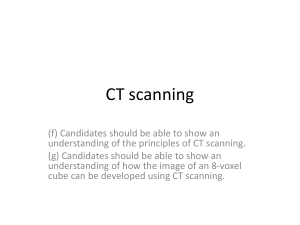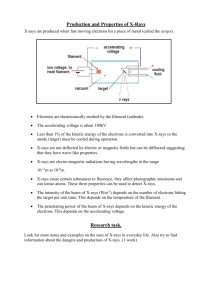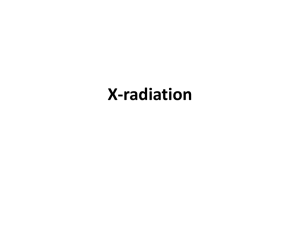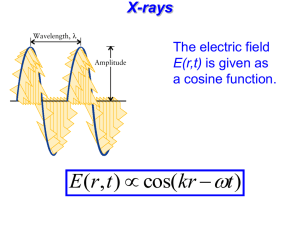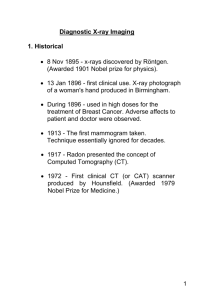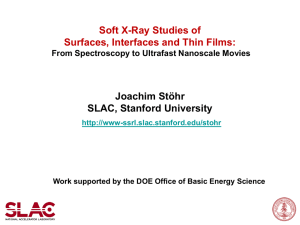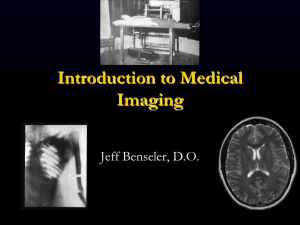Lecture 24 Presentation
advertisement
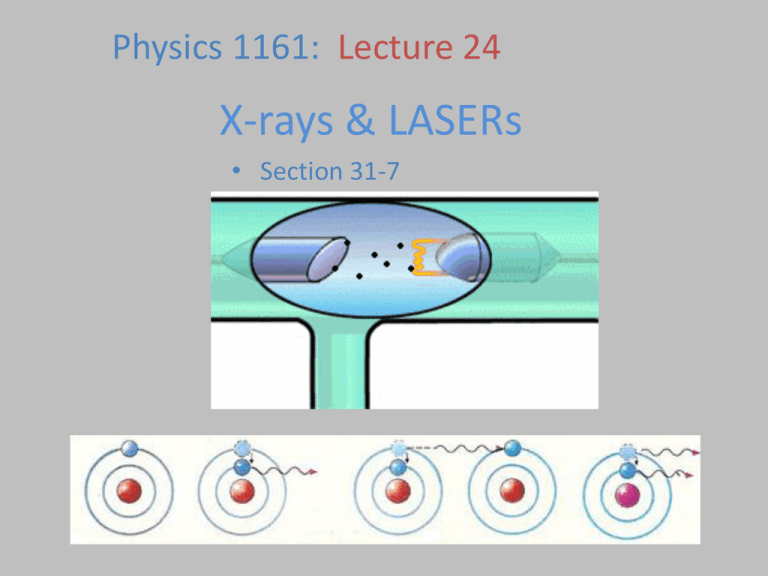
Physics 1161: Lecture 24 X-rays & LASERs • Section 31-7 X-Rays Photons with energy in approx range 100eV to 100,000eV. This large energy means they go right through you (except for your bones). What are the wavelengths? hc E 1240 eV nm E 1240 eV nm 100000 .01 nm to 10 nm eV . 01 nm 1240 100 10 nm X-Ray Production How do you produce 100 eV photons? • Black Body Radiation – Would require temperature over 10 times hotter than surface of sun • Excitation of outer electrons – Typically have energy around 10 eV • Radioactive Decays – Hard to turn on/off Electron Tubes • Accelerate an electron through a voltage difference to give it some energy... An electron is accelerated through a potential difference of 70,000 V. How much energy does it emerge with? Recall: U = qV KE = U = (1 e-) (70,000 V) = 1.6 x 10-19 C U of voltage gap becomes K.E. for electron. = 70,000 eV = 11.2 x 10-14 J From Electrons to X-Rays • Now take these high energy electrons (up to 100,000 eV) and slam them into heavy atoms - any element. • 2 kinds of X-Rays are produced: – “Bremsstrahlung” – “Characteristic” Bremsstrahlung X-Rays • Electron hits atom and slows down, losing kinetic energy. – Energy emitted as photon • Electron hitting atom makes many photons (X-Rays), all with different energy. – Many different wavelengths. intensity 0 • If all of electron’s energy is lost to a single photon, photon has maximum energy (minimum wavelength). – Minimum X-Ray wavelength = o. Bremsstrahlung Practice An electron is accelerated through 50,000 volts What is the minimum wavelength photon it can produce when striking a target? Minimum wavelength Maximum energy Electron loses ALL of its energy in one collision and emits one photon. hc = 1240 eV·nm or 1.99*10^-25 J·m intensity 0 hc E 1240 eV nm 50, 000 .0248 nm 0 Characteristic X-Rays Electron knocks one of the two K shell (ground state) electrons out of an atom. L (n=2) or higher shell electron falls down to K shell (ground state) and x-ray photon is emitted e- e- e- e- e- L shell (n=2) K shell (n=1) e- (high energy electron) Characteristic x-ray nomenclature n=1 “K shell” n=2 “L shell” n=3 “M shell” Characteristic X-Rays Electron knocks one of the two K shell (ground state) electrons out of an atom. L (n=2) or higher shell electron falls down to K shell (ground state) and x-ray photon is emitted e- e- e- L shell (n=2) L shell electron falls down e- e- K shell (n=1) Characteristic x-ray nomenclature n=1 n=2 n=3 “K shell” “L shell” “M shell” X-Ray photon emitted “K X-ray” (n=2 n=1 transition) Kb X-Rays K X-rays come from n=2 What about n=3 n=1 transition. n=1 transition? Not as likely, but possible. Produces Kb X-Rays! Kb X-Rays are higher energy (lower ) than K. (and lower intensity) K intensity Kb Different elements have different Characteristic X-Rays All Together Now... intensity Brehmsstrahlung X-Rays and Characteristic X-Rays both occur at the same time. intensity intensity 0 Kb K Kb K X-Rays Checkpoint K Kb Kb 0 These two plots correspond to X-Ray tubes that: (1) Are operating at different voltages (2) Contain different elements (3) Both (4) Neither 0 K X-Rays Checkpoint K Kb Kb 0 0 These two plots correspond to X-Ray tubes that: (1) Are operating at different voltages (2) Contain different elements (3) Both (4) Neither K and Kb are the same o is different K Which graph corresponds to the tube being operated at the higher voltage? 1. Top 2. Bottom intensity Kb K 70% intensity Kb K 30% 1 2 Which graph corresponds to the tube being operated at the higher voltage? 1. Top 2. Bottom intensity Higher voltage means higher energy deceleration x-ray photon can be produced, or smaller maximum wavelength, 0. K and Kb are the same for each! Kb K 78% intensity Kb K 22% 1 2 LASER A device which produces light or some other form of electromagnetic radiation that is monochromatic (of a single wavelength), coherent (in step), and contained in narrow beam • • • • • Light Amplification by Stimulated Emission of Radiation Laser Operation Laser • A laser is a device that creates and amplifies a narrow, intense beam of coherent light. •In a ruby laser, light from the flash lamp, in what is called "optical pumping", excites the molecules in the ruby rod, and they bounce back and forth between two mirrors until coherent light escapes from the cavity.
